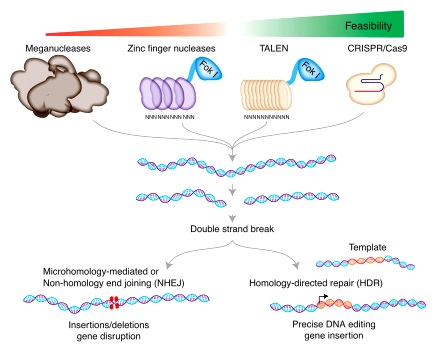Positive Health Online
Your Country

Wired Grandeur – Fixing the Faulty Gene
by Rajgopal Nidamboor(more info)
listed in dna gene expression, originally published in issue 293 - March 2024
Originally published at
https://thehimalayantimes.com/opinion/wired-grandeur-fixing-the-faulty-gene
There is a dazzling biology at work inside the brain, including its colossal appetite to storing information. Agreed that information technology has made ‘relative’ the need for long-term memory in the brain passé, but as new re-search augurs, this may call for the greater use of our working memory — not so much our storage memory. Just think of it. Our memories in the future may emerge in the form of a pill — a pill that expands our ‘normal’ memory. Such a pill, ‘in the works,’ has already been used in patients with memory loss, or Alzheimer’s disease, with promising outcomes.
https://en.wikipedia.org/wiki/File:MEGANUCLEASE-ZFN-TALEN-CRISPR-text-to-path.svg
Schematics of the use of meganuclease, zinc finger nuclease, TALEN and CRISPR nucleases for genome editing.
Credit: Mazhar Adli on Wikipedia
Now, picture this — as our ability to access and share information may only fast-track, our brains will be defied to think and make decisions at the speed of thought. Anyone who falls short of it may be ‘lost,’ unless one augments one’s intuition and ‘gut feel-ings,’ with expanded zest. Add to this yet another type of memory that occurs in the form of genetic materi-al, the DNA, the blueprint for the body, or chemical reminiscence, for genetic, or personality, qualities passed down from generation to generation, and you have it all — the human genetic map. A ‘chart’ that helps locate biomarkers for diagnosis, preventative and curative treatment of hereditary disorders — including diseases of the brain.
You get the idea — gene therapy. Gene therapy is di-rected towards replacing faulty genes with ‘un-spoiled’ ones. The therapy is far from perfect yet, but what takes the cake is a ground-breaking, state-of- the-art strategy called chi- meraplasty (targeted gene correction), in which a cell is stimulated to refurbish its own defective genes.
Chimeraplasty was first developed by Drs Eric Kmiec, Kyonggeun Yoon and Allyson Cole-Strauss at Thomas Jefferson Universi-ty, Philadelphia. Kmiec worked to create a hybrid DNA-RNA molecule (a chi-meraplast) that would be stable long enough to permit gene repair. New advances made in the understanding of the mechanisms and pathways by which correction is brought about will only expand our knowledge of the technique. New research on whether it will become a prevalent method of battling inherited disease is gaining ground.
The point also is certain organs, such as the liver, are more acquiescent to its use. The best part: the usage of the technique will only expand as progress in the field would inescapably be supplanted by facts that permit chimeraplasts and single-stranded oligo- nucleotides (DNA or RNA molecules) to reach their full potential.
Yes, the road to the future is more than exciting as genetic information would lead to tests in the mother’s womb, or early in life. This will be a boon to detect markers that suggest genetic predispositions to conditions, such as obesity, not to speak of emotional disorders. The scientific spin-off would be imminent as one would have that ‘magic wand’ to devise lifestyles that integrate medical analyses with pre-emptive, corrective treatment — for optimal health and wellness.
It’s not that everything would be hunky-dory with such advances — one must be realistic of possibilities, because genetic medicine will not peremptorily enable us to predict your individual phenotype, or body structure. This is because your phenotype is not just the expression of genetic information, but also the outcome of environmental influences and life experiences.
Let us pick a paradigm to bring home the point — the phenotype for brain disorders could range anywhere from ‘zero-symptoms’ to complete disability, although the paradox is one cannot ‘tap’ identical twins with hundred per cent ‘zero-error’ in such an instance.
Nature is a temple of surprises, also enigma. To state the obvious — neither health nor any ‘make-up’ of the human brain and body is predestined, or predictable. To cut a long story short — our environment and behaviour may modify our brains, just as much as autonomy and creative licence can augment, or‘ jazz-up,’ our behaviour.
Yet another ‘downside’ is gene treatment that alters one gene may impinge on different qualities, including behaviours that we do not want to change. The same gene linked to heart disease, for instance, could just as well influence our brainpower, intellect, or creativity. It all, therefore, boils down to risks — that altering a gene may not be a good idea for disorders associated with multiple genes.
While medicine has ‘engineered’ the advent of wonder, or miracle, drugs being replaced by the more wonderful drugs of tomorrow, most sceptics are ‘aiming their perceptive guns,’ in more ways than one, while substantiating the credo that drugs, in any form, only ease symptoms, not the disease per se. Add to this new research that overwhelms illnesses with trophic factors, or specific substances, that ‘fuel’ and replace degenerated cells, and you’ve a remarkable opus.
This is not all. When computer designed molecules fit precisely into specific receptors for the purpose of treating diseases, the transcendent idea of genetically engineered plants to produce pharmaceuticals is poised to take medical treatment to a whole new level — absorbing drugs by simply eating the plant food. This could be ‘blasphemy’ for sceptics, because the human body is not a machine operating independently of the mind.
This brings us to the one big question that has begun to haunt medical research more than ever before. Will ‘tweaking’ our brain, or body systems, rob us of our ability to cultivate loving relationships, or influence longevity and/or the capacity to live in harmony with ourselves and others?
Credit Acknowledgement
Originally published at
https://thehimalayantimes.com/opinion/wired-grandeur-fixing-the-faulty-gene
Comments:
-
No Article Comments available
